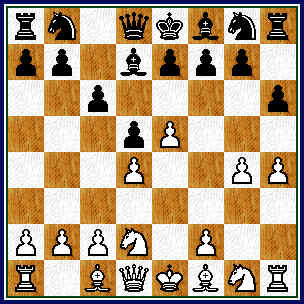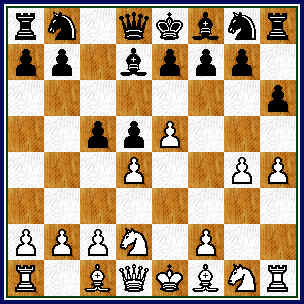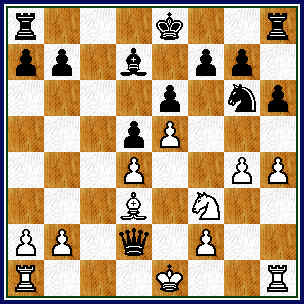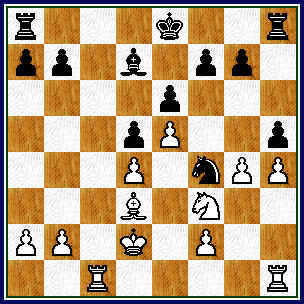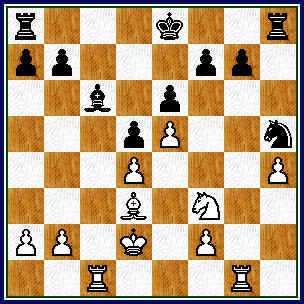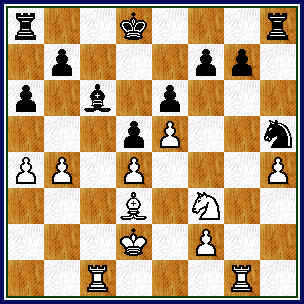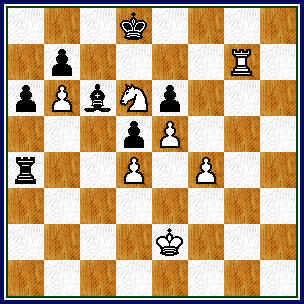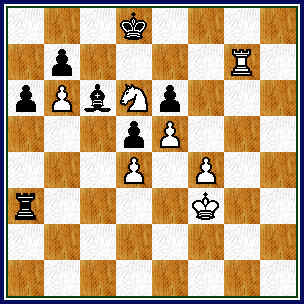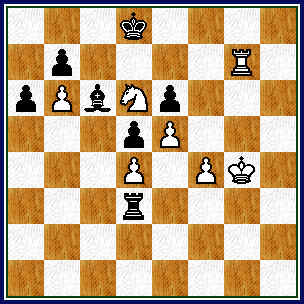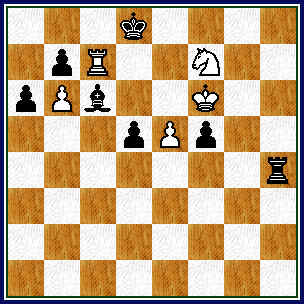All
the |
(Navigation bar
directly below.)
*******
© A.J. Goldsby, 2015.
(All rights reserved.)
****************
Click HERE
to see my
Chess Items.
****************
****************
Buy a book
from Amazon.com
(And help me out as well!)
****************
Click HERE
...
to see a list of the businesses that help to sponsor all of
my chess efforts.
Kramnik - Leko; WCC-2004 (#14)
This was a game that has already been talked about quite a bit, and even annotated on a couple of web sites. So much was said about this game - much of it, I felt had to be incorrect - that I decided to annotate it. I also thought it might be useful to find out where Leko went wrong ... exactly what the losing move was.
{There were MANY mistakes in this contest.}
[ The official web site. ] [ The ChessBase report. ] [ The LCC/TWIC report. ]
This game has (now) been updated ... several times. (10/31/2004 and 12/03/2004)
Click here to see an explanation of all the symbols that I commonly use when annotating a game.
Click here to re-play this game ... on another server. (This is not my site, please do not write me about the content!)
Click here to see Kramnik's analysis of this game. (Link may no longer be valid. Friday, June 15th, 2007.)
GM Vladimir Kramnik (2770) - GM
Peter Leko (2741);
|
|
(C.A.
= Counter-Attack. A Counter-attack is any opening which
does not immediately |
2.d4 d5;
3.e5!?, ('!') (Phalanx)
I have always said that the
Advanced Variation was a very
good choice for White against
the Caro-Kann, (even when
most opening books were united
in their condemnation of it!).
Furthermore, as this game amply proves, White gets an edge and it is not real clear exactly what the best method is for Black to proceed with, in order to gain full equality. Yet another consideration is that these {murky?} theoretical waters are not very well explored.
As I have pointed out to several of
of my Internet students ...
White forms a pawn wedge (in
the center) that dominates
play ...
right to the end of the game!
[ The main line is:
3.Nd2 dxe4;
4.Nxe4, "+/=" 4...Nd7;
"<=>" {Diag?}
see any good opening book. ]
3...Bf5;
4.h4!?,
A very tricky move ... and seemingly
just a transposition here.
(The
'normal' move order, if you can
call this line normal, is for
White to play g2-g4 here.)
[ The more usual move order for
this line would be:
4.g4 Bd7!;
{Diagram?}
and is the way you find this
variation in most books. ]
4...h6!?;
(Escape square ... for the Bishop. Prophylaxis?)
A relatively little-used move,
especially at the GM-level.
(A little more normal is the
move of ...h7-h5; see the note
just below.)
*******
[ An alternative here is:
>/= 4...h5!?; {Diagram?}
with a fair position.
[ See MCO-14; page # 185; column # 47, and all notes. ]
*************************************************************************
Black should definitely NOT play:
</=
4...e6??; 5.g4 Be4; 6.f3 Bg6?!;
7.h5, "+/-" {D?}
and White has won a piece.
(This trap shows one of the main
points of all of White's
various
{early} pawn advances.) ]
*******
5.g4 Bd7;
('!')
This is not a new position, the database shows that it has been reached
dozens of times at the master level. (There are 198 examples of this line
in the CB database alone!)
Probably the most notable previous use of this position came in a WCS Match ... Mikhail Tal's disastrous title defense against M. Botvinnik in 1961. Tal reached this position twice in that match ... and lost BOTH games!!! {See the CB web site for more details.}
[ If Black goes the other way ...
he courts problems.
I.e.,
</= 5...Bg6?!; ('?')
6.h5 Bh7; 7.e6!,
"/\" "--->" {D?}
gives White a very strong attack.
(The computer is already
showing
a large edge ['±'] for White.) ]
It is quite obvious to me that
Kramnik's next move was prepared
well in advance
of this match.
6.Nd2!?,
(Maybe - '!')
TN!!!
{See
the diagram - just below.}
Believe it or not ... repeated db
searches, (of MANY sources!); leads me to
realize that this is
probably the very FIRST time
that this move has occurred ...
at least in master practice.
*******************************************
*******************************************
For
those who say that chess is
completely played out, I offer the
court:
<< People's Exhibit number One. >>
Only six moves ... and we are out of book!!
[ A good example of previous
- successful! - (recent) master
practice
would be:
6.h5!? c5; 7.c3 e6;
8.f4 Nc6; {Diagram?}
This is probably best.
*** *** *** *** *** *** *** *** *** *** *** *** *** *** *** *** *** *** *** *** *** *** *** ***
( Or 8...Qb6!?; 9.Nf3, "+/=" {Diagram?}
yields a solid plus, and ...
"leaves White in control of the
Kingside."
- GM Nick de Firmian
GM Mikhail Tal - GM Ludek Pachman; /
ICT / Bled, Yugoslavia; 1961.
(Replay
this historic game.)
[ See MCO-14, page # 185; column # 47, and note # (s.). ] )
*** *** *** *** *** *** *** *** *** *** *** *** *** *** *** *** *** *** *** *** *** *** *** ***
9.Nf3 Qb6; 10.Kf2!?,
"+/=" ('!') {Diagram?}
and White builds on his very
obvious edge in space.
GM Michael Adams
(2640) -
GM Alexander Khalifman (2645);
ICT / PCA Open, (play-off)
/
New York, NY/USA; 1994.
{White won, 1-0, in 49 moves.}
]
6...c5!?; (hmmm)
{See the diagram - - just below.}
While this move was praised by
some on-line commentators, it
did not really thrill me.
*******************************************
*******************************************
Maybe this move would not have been so bad ... if Black would have followed it up differently here.
[ Maybe (>/=) 6...Qc8; {Diagram?} here instead?
**********************************************************
Probably the most solid move would have been:
6...e6;
{Diagram?} fortifying the
center and also
preparing the c6-c5 advance. ]
************************************************************
White could play c3 here, but his response is more challenging and energetic.
7.dxc5,
Kramnik gives up his center with this play,
but now Leko has to work
hard to get the Pawn back.
[
Slower and more solid was:
7.c3,
{Diagram?}
protecting the center ... but
obviously Kramnik did not feel
that such a cautious move was
appropriate to his "must win"
situation in this game. ]
7...e6!?; (Maybe - '?!')
This strikes me as a tad slow,
White now gets a solid plus.
[ An improvement just might be:
(>/=) 7...Qc7!?; 8.f4,
{Diagram?}
This could be best here.
( >/= 8.Ngf3?! Nc6!; "=" )
8...Qxc5;
9.Bg2,
"+/=" 9...e6;
"~" {Diagram?}
White might have a tiny plus ...
I interpret this position
as being
rather unclear and positionally
vague as well. ]
8.Nb3 Bxc5!?;
(Probably - '?!')
This is simply ill-advised and
somewhat hasty ... White achieves
- and
keeps - a very solid and also
a very substantial advantage now.
[ Another idea here was:
(>/=) 8...Qc7;
9.f4 h5!!; 10.g5 Bxc5; 11.Ne2 Bb6;
12.Ned4,
"+/=" 12...a6; {Diagram?}
and Black has a much better
time of it than in the game.
***************************************************************************
A possibility mentioned by some commentators was:
>/= 8...Ba4!?;
"~" {Diagram?}
with the idea of taking the Knight on
b3, followed by ...Bxc5.
(This also might have been a small
improvement over the game.) ]
9.Nxc5 Qa5+;
10.c3 Qxc5; (Assess this position - who
is better?)
"Black is perfectly OK here, both
Kramnik and Leko agreed on
this
after the game." - The London Chess Center
[ go
there ]
Despite what was said above,
the computer clearly shows a
massive edge
for White. If Peter
Leko does not play absolutely perfect chess from here,
he will be
squashed like a bug.
11.Nf3!?,
"D" (D
= Development.) {Diagram?}
While perhaps sound, this was not
the sharpest move here.
*******
However, White enjoys a very nice advantage with this flexible move.
Additionally, White also has the
Bishop pair, and can make Black
suffer for
a very long time -
as this game clearly shows.
[ After the moves:
(>/=) 11.Be3 Qc7; 12.f4,
"+/=" ('±') {Diag?}
White's edge is very large. ]
11...Ne7!?;
(hmmm)
While seemingly a logical
developing move, I prefer to
retreat the Queen
immediately
to c7 - White will gain a tempo
with Be3 anyway.
[ Maybe better is: 11...Qc7. ]
The on-line commentator ...
(GM R. Knaak); for the official website, did not
care for White's
next move ... but I think it is
both good and logical.
12.Bd3!? Nbc6;
13.Be3 Qa5; 14.Qd2 Ng6!?;
"The correct choice," ... said the
pundit for an ICS, ...
but Black
definitely had a better move.
[
RR
>/=
14...d4!;
"<=>" {Diagram?}
This seems to be a MUCH more
active choice for Black
than the
actual game ...
and the computer
approves of it as well.
Although I did not know it, many players (and commentators)
were apparently looking at this
move ... on several different
servers.
{I have received several e-mails about this matter ... I never
claimed to have been the first
person to discover this move.
It was just that when I was analyzing
this game with Fritz, the
computer also preferred this move
in this particular situation.} ]
***
(Editor's
note: for a brief analysis of this move, see the CB article
on
this highly intriguing game. - Link at beginning of this page.)
*******
White ignores the chance to
capture on g6 and double Black's
Pawns -
it would have led
nowhere ... in a big hurry.
15.Bd4! Nxd4;
16.cxd4 Qxd2+?; (This is totally inept
here ... but why?)
{See the diagram below.}
Without a doubt, a bad move
here; I literally groaned when I
saw that Leko had played this
move. (Black is in too large of a
hurry to be swapping the Q's.) [The losing
move?]
*******************************************
*******************************************
After
this - Black's large lag in his development begins to tell.
(As far as I can tell, no other commentator has pointed this out yet.)
After
the exchange on d2, the latest version of HIARCS shows a swing
in
the evaluation of the position of nearly a point-and-a-half!
The
change in the "eval's" of the position by most
computer programs ...
is simply huge. (And in favor of White!)
*******
The REASON(S) that this move is completely wrong are:
#
1.) That after the exchange of the Queens, the
second party has left
White much further developed;
#
2.) Kramnik is now firmly in charge of ALL the {remaining}
open lines ...
both open files and key
diagonals;
#
3.) The first party has many times more usable
space than Black does
in the resulting
position;
#
4.) We have also gotten one step closer to an
end-game ...
that is absolutely
miserable for Black! {Good N vs. bad B.}
*******
Originally
I had only awarded this move a dubious appellation ...
but after studying this game for days, I decided it was truly worthy of a
full question mark - even if that appears somewhat
harsh.
*********************
[ Much better than the game,
was the continuation:
>/= 16...Qb6;
17.g5!? h5!; 18.Rc1 0-0; 19.Rc3,
"+/=" {Diag?}
White has a small edge, but
nothing that cannot be
defended
against with best play. (I spent many hours with the
box ...
testing various lines.) ]
17.Kxd2 Nf4;
18.Rac1,
Immediately occupying the file.
Kramnik
could have retreated his Bishop here, but apparently his excellent chess
instincts told him that he had nothing to fear from a
"NxB" trade on the d3-square.
(Leko's sorry d7-Bishop is doomed to play the role of spectator for the
remainder
of the game - rather than that of the active participant.)
[
Several on-line commentators suggested that White play:
(</=) 18.Bf1!?,
{Diagram?}
to retain the
Bishop.
(White will
continue with Ke3 on the next move, with
the much
better game. "+/=" ) ]
18...h5?!;
(Oh-no!)
{See
the diagram, just below here, please.}
This supposedly active move ...
could be the proverbial straw
which broke the camel's back.
*******************************************
*******************************************
It
is also a violation of principle,
when (far) behind in development, (...)
you NEVER open lines! (Never, never,
never!!!)
[ After the moves:
>/= 18...Nxd3;
19.Kxd3 Bb5+; 20.Ke3 Kd7; 21.b3,
"+/=" {D?}
White has a very solid edge.
(But I never found a forced win,
and I spent about 45 minutes
with Deep Junior, looking for
a
winning line from here.) ]
19.Rhg1! Bc6;
20.gxh5 Nxh5!?; {See
the diagram ... just below.}
Possibly another dubious move,
The IRON HORSE, (Fritz 8.0); is
(instead) recommending that Black
exchange on d3 (first) and only
then play ...Kf8. (Black will be able
to {eventually} gather in the stray
button on the h5-square.)
*******************************************
*******************************************
After about 30 minutes of machine time, one program awards White more than a one-point edge here.
[ Maybe just 20...Kf8!?; here? ]
White
now plays his position with
great energy - although Ke3 was
also worthy of consideration here.
21.b4! a6!?;
{Box?}
{Diagram?}
This move looks forced, (And is also
the first choice of Fritz 8.0!); ...
although the LCC web site assigns
this move a question mark, (but
does
not bother to tell us which
move is better). Argh!
[
Even worse would be:
</= 21...Rc8?!;
22.b5 Bd7; 23.Rxc8+ Bxc8; 24.Ke3! Bd7;
25.Rc1, '±'
(Maybe "+/-")
{Diagram?}
and the
"box-of-chips" ...
says that White is basically winning here. ]
*** *** *** *** *** *** *** *** *** *** *** *** *** *** *** *** *** *** *** *** *** *** *** ***
White's next move might be a double-exclam ... despite what the fish on
one chess server said about this play.
(White's next play is an attempt to
completely refute Black's opening
strategy ... in this game.)
Aside from the text move, Ke3 has also been recommended by several pundits
...
but it strikes me as a little bit slower than the actual continuation
chosen in the game.
22.a4! Kd8?!;
('?')
{See the diagram ... just below.}
This looks very awkward - and also causes an immediate change in
the computer's assessment of the position here. (Without a doubt, the move
...Kd8; is very bad and possibly worthy of a full question mark here. The only reason I do not
wish to be hard on Leko here... is that he was already growing critically
short on time. Another reason that I do not award this move a full
question mark - after deep reflection, over a period of several days - is
that analysis will clearly demonstrate that nothing might save Black's
game at this point, anyway.)
*******************************************
*******************************************
Now Leko's position was working against him, as he battled with the clock as well here. (And this was probably one of the reasons that Leko was unable to find the way out of this mess.)
[ After the following continuation:
>/= 22...Bxa4;
23.Rc7 0-0!?; 24.Ng5! Bb5!?; {Dm?}
(Several programs want to play
this move here, however
it may
be that
24...b6; is a safer try.)
25.Bh7+ Kh8; 26.Bc2!,
'±' {Diagram?}
White is clearly much better, but
at least I don't see a
forced win
this position. (...Kg8; Bd1!) ]
23.Ng5 Be8[];
24.b5!?, ('!')
White continues to press forward.
[ Maybe 24.Ke3, '±' {Diagram?} is (also) good? ]
24...Nf4;
(hmmm)
This looks practically forced -
several programs confirm this -
yet Leko has lost a great deal
of time with this Knight here.
[ </= 24...axb5?!; 25.Bxb5!, '±' ]
Kramnik's next move ... "made him happy." (LCC)
25.b6! Nxd3;
(hmmm)
This capture could also be a
little premature, but I have no
way of being 100% sure without many hours of analysis.
It is worth noting ... that this is the SIXTH move that this piece has
made in this
game! (N/g8-e7-g6-f4xh5-back to f4, and now captures on d3.)
[ Black could try to adopt a
defensive blockade, but after:
RR
25...Rc8!?;
26.Rxc8+ Kxc8; 27.Rc1+ Kb8; 28.Rc7 f6;
29.Nf7 Bxf7; 30.Rxf7 f5;
{Diagram?}
Leko's position remains grim.
***************************************************************************
Even worse for Black was:
</= 25...f6?!; 26.Nf3
Nxd3; {Diagram?}
This is virtually forced.
*******
( Bad is:
</= 26...Bh5?; 27.Ne1! fxe5!?; 28.dxe5 g6!?; {Diag?}
This looks ugly, but Black
cannot allow both of White's
Rooks to reach the 7th rank!
29.Rc7 Rb8; 30.Nc2 Nxd3; 31.Kxd3 Bf3!?; 32.Nd4 Be4+;
33.Kd2 Re8; 34.f3 Bf5; 35.Nxf5 exf5; 36.Rxg6, "+/-"
{D?}
and White is winning easily. )
*******
27.Kxd3 Bh5; 28.Nd2 fxe5!?;
{Diagram?}
If ...Rc8; White simply exchanges
Rooks, followed by Rxg7 -
with a
dominating position.
29.dxe5
Rc8; 30.Rxc8+ Kxc8; 31.Rxg7, "±"
(Probably "+/-")
{D?}
and White is hugely better. ]
Black is soon forced into playing
...Rc8; once Leko loses control
of this
critical open line, his
situation worsens considerably.
26.Kxd3 Rc8;
27.Rxc8+ Kxc8; 28.Rc1+ Bc6[];
Apparently this move is forced here.
Black has blocked the c-file ... but has not kept
the White Rook out,
but now the 'heavy' ... finds another avenue to penetrate into
Black's
position from here.
[
The endgame that arises after the following moves:
</= 28...Kb8?!;
('?') 29.Rc7
Rxh4; 30.Nxf7 Rh3+;
31.Kd2 Bxf7; 32.Rxf7 Rh8!?;
33.Rxg7, "+/-" {Dg?}
is almost completely hopeless
for Black.
(This is certainly much worse
than the continuation
that actually
transpired in the game.) ]
Now
White buries a Knight into the d6-square. In a similar
situation,
Steinitz once said a Knight that is firmly anchored on the sixth rank ...
"is like a bone that is stuck in your opponent's throat."
Not
being able to defend any of the real threats ... and convinced that
passive play will {now} lose ... GM Leko keeps himself busy by
munching
as many Pawns as he possibly can.
29.Nxf7 Rxh4; 30.Nd6+ Kd8;
31.Rg1!?,
This looks both natural and very logical as well.
[
The strong program, Fritz 8.0 greatly prefers the move:
31.Ke3!?,
'±' ("+/-")
Maybe - '!'
{Diagram?}
with a nearly won position for
White from here. ]
31...Rh3+;
32.Ke2 Ra3; 33.Rxg7 Rxa4; 34.f4!!,
(nice)
{See the diagram just below here.}
A very bold decision.
*******************************************
*******************************************
Take a look at this position.
This moves might be easy - now - for me to find. But I have already watched this entire game on the Internet today, I heard all the expert commentary, I have had hours to analyze the game, I sit at my desk in complete relaxation, and I also have Fritz running in the background as well here.
White will wind up sacrificing many of his Pawns in an almost cavalier fashion. I am sure that finding all of these shots over the board were not nearly as easy as they are for me now!
*********
White's
play is now centered around two very pleasing themes:
# 1.)
He will advance f4-f5, freeing his extremely dangerous
KP;
# 2.)
With Black's King almost completely boxed in, Kramnik will march his
King all the way
around to the King-side, usually winding up on the
sixth rank. This
will create strong, truly unbearable pressure against
Peter Leko's King.
*********************
[ Also possible was: 34.Kd3!?, "+/=" {Diag?} with a tangible edge here. ]
34...Ra2+!?;
The immediate ...Rxd4; was also
interesting, but probably inferior to
the move actually played.
[
Black could have tried the following continuation ... which also loses:
(</=)
34...Rxd4!?; ('?!')
35.f5!! exf5; 36.e6! Re4+;
{Diagram?}
This is forced, (believe
it or not).
*******
( Even worse would be: </= 36...a5??; 37.e7+
Kd7; {Diag?}
White's next move is a DOUBLE check ... leaving Black no
choice but to try and run away.
38.e8Q+ Kxd6[]; 39.Qe7#. )
*******
37.Nxe4 dxe4; 38.Rc7! Ba4;
{Diagram?}
This is forced, White was
threatening the winning sack on the
c6-square ... to be
followed by simply promoting a pawn.
*** *** *** *** *** *** *** *** *** *** *** *** *** ***
Now I do NOT claim that the next series of moves are forced or
best.
It is just a sample line
similar to what I analyzed with several Internet
students.
39.Ke3! Bb3; 40.e7+ Ke8; 41.Rxb7
a5; 42.Kf4 a4!?; 43.Rc7 Bd5;
44.Ke5! Bb3;
{Diagram?}
Something like this is forced.
*******
( After the moves: ("=") 44...e3!?;
45.Kxd5! e2; 46.b7 e1Q;
47.b8Q+ Kf7; {Diagram?}
(Now a double-check by White.)
48.e8Q+ Kf6; 49.Qbd8+, ("+/-") {Diagram?}
Black also gets mated. )
*******
45.b7! Be6!?; 46.Kxe6!, "+/-"
{Diagram?}
and mate next
move.
(NOTE: I stuck this line in because I got several phone calls and
also about 10 to 15
e-mails ... almost everyone wants to know
how Kramnik would have
won after ...Rxd4; in this line.
Tuesday; October 26th, 2004.)
*********************************************************************************************
*********************************************************************************************
Another idea - that Black does not have time for - would be:
</= 34...Rb4?; 35.f5! Rxb6;
{Diagram?}
Continuing with the plan.
*******
( Not </= 35...exf5?; {Diagram?}
(This is a terrible mistake.)
as after: 36.e6!, ("+/-") {Diagram?}
Black will have to quickly give
up his Rook
to try and avoid
the impending mate. )
*******
36.fxe6 Rb2+; 37.Kf3 Be8[];
{Diagram?}
This is forced ... otherwise White
will advance the pawn, taking full
advantage of a double-check to
promote the foot-soldier on the
e-file,
from here.
38.Rg8 Rb3+; 39.Kf4 Kc7; 40.Rxe8
b5!?; {Diagram?}
Trying to make it a foot-race
... anything else is hopeless.
41.Ra8 Kb6; 42.e7,
"+/-" {Diagram?}
Black cannot prevent the Pawn
from advancing to the queening
{promotion}
square from this position.
]
35.Kf3 Ra3+;
35.Kf3 Ra3+;
{See the diagram - just below here.}
Black has been slowly sliding
into the abyss ... with his minus
on the clock,
I doubt that Leko
had any practical chance to
really save this game from here.
*******************************************
*******************************************
Take a look ... and decide for yourself.
36.Kg4! Rd3?;
(YUK!!)
{See the diagram ... just below.}
Now Black's position will take
a drastic turn for the worst.
*******************************************
*******************************************
Now White - playing with truly great, admirable skill - throws away his Pawns to weave a mating web around Peter Leko's King.
[
RR After the moves:
>/= 36...Ra1; 37.Nxb7+ Bxb7;
38.Rxb7 Rg1+; 39.Kh5,
'±' {Diag?}
Black is a Pawn down, and the
box says that Black is
completely
busted - but it is
still an improvement over the
actual text move. ]
**************
The rest is merely a display of
Kramnik's considerable technique.
(The box says that ...Rd1!; was a
much better move for Black on
move thirty-seven.)
It was only after Black's next move that the boxes began to grasp that Black was lost.
Note that White's play from this position is VERY thematic
...
Kramnik plays almost exclusively on the weak dark
squares.
37.f5! Rxd4+?!;
38.Kg5! exf5; 39.Kf6! Rg4; 40.Rc7! Rh4?!;
Putting the Bishop on d7 was
a far trickier try - it would have
lasted longer, and coming just
before time control, would have
caused Kramnik to think.
41.Nf7+, Black Resigns, (1-0.) {See the diagram ... just below.}
It is now mate in two ... ("+/-")
... definitely a good time to quit!
(Editor's note - work it out ... or fire up
your computer!)
*******************************************
*******************************************
A great game by Kramnik ... but Leko could not have played any worse, I think. Also - his opening was simply horrible - you expect that kind of play from a Class "C" player, but not a WC Candidate!!
Copyright (c) A.J. Goldsby, 2004. All rights reserved.
1 - 0
This game - the raw HTML code was {initially} generated with the program, ChessBase 8.0.
I started analyzing this game as soon as the first move was made, I finished the great part of my analysis late last night, after the NFL game. (St. Louis defeated Tampa Bay.) But of course, I then had to format the game ... this took approximately 4-5 hours of constant work. (I also had to then create the diagrams for this page.) I was not really planning on analyzing this game ... it was just that many friends/contacts, (as well as yours truly); had so many questions after the game, ("Why did Leko lose?" "Where did he go wrong?") ... that I decided to go ahead and try to tackle this game. (It was not part of my work schedule, and interrupted many regular, paying projects. But what the hay, a WCC Match does not come along every day!!!)
I realize that many of the opinions that I have put forth here will be somewhat controversial ... much of what I say may not be accepted. This does not matter to me. I achieved several goals here, with this page. (Timeliness and also some pretty good analysis. I also wanted to find where "the losing move" was played, I think that I have done that as well.)
In the end, every page will be judged on its own merit. Certainly this one has something to add to the debate on this game ... it also has many things that other pages do NOT offer. (Like handy links to other sites' analysis of this contest!)
Enjoy this game, and please respect my copyright. & Please let me know what you think of my work, as well. (Thanks!)
If you have any
questions about this game - please contact me.
A.J. Goldsby; P.O. Box 11718;
Pensacola, FL 32524 (USA)
[ I no longer offer the CB version of any game. Too many people that will
not respect ANYONE's copyright!! ]
Tues; October 26th, 2004: I received so much e-mail about this game ... that I decided to update this game in a major way. I spent several days re-analyzing key lines, polishing the wording, etc. It is nice to be timely ... it is even better to take your time and do it right. Hopefully now, more ideas will be explained and more questions answered.
Sunday; November 21st, 2004: This game continues to generate interesting comments and e-mail. Thanks to everyone who has written and sent in analysis! I currently have no plans to re-do this particular game.
Copyright (c) LM A.J. Goldsby I
Copyright (©) A.J. Goldsby, 1985 - 2015. All rights reserved.
*******
This page was created in October of
2004.
I finished annotating this game the night of October 18th, 2004.
The final formatting of this page
was completed on: Tuesday;
October 19th, 2004.
(I did a major update on this game on: Tuesday;
October 26th, 2004.)
This page was last modified or edited on: Tuesday, April 28, 2015 02:07 PM .
[ Home, (for this site). ] [ Return (or go to) to "Annotated Games." (#1) / (Or #2.) ]
[ Top of (this) page. ] [ Click HERE to go (or return) to my pages for this match. ]
[Return (or go to) to the (page for) "Best Games."] [ Go to my personal domain. ]
